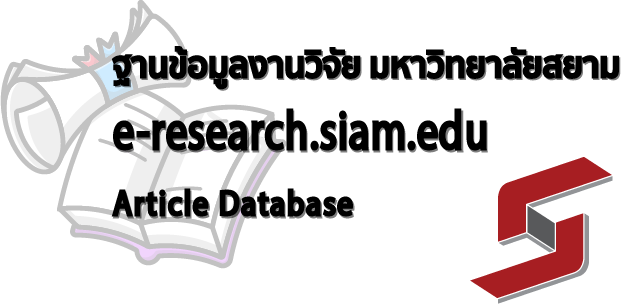- KB Home
- Comparison of Stroke Warning Signs Perception, Self-care Behaviors andFamily Support between controlled and uncontrolled hypertensionsin in the Responsible Area of Bang-Krai-Nai Subdistrict Health Promoting Hospital, Nonthaburi Province
Research Article : Comparison of Stroke Warning Signs Perception, Self-care Behaviors andFamily Support between controlled and uncontrolled hypertensionsin in the Responsible Area of Bang-Krai-Nai Subdistrict Health Promoting Hospital, Nonthaburi Province
Author : Ruttakarn Kamkhiew and Chanida Mattavangkul
Email : rut_kamkaew@siam.edu , chanida.mat@siam.edu
Department : Faculty of Nursing, Siam University
Published : Disease Control Journal (วารสารควบคุมโรค ) Volume 44 (2) Apr – Jun 2018
Abstract
The present study was aimed to compare the perception of stroke warning sign, blood pressure behavior and family support among controlled and uncontrolled hypertensive patients in the responsible area of Bang-Krai-Nai subdistrict health promoting hospital, Nonthaburi province. 210 samples who were diagnosed with hypertension at least a year were collected from June 2016 until May 2017. Instruments used in data collection included demographic data form, perception of stroke warning signs, blood pressure controlled behavior and family support. Cronbach’s alpha correlation coefficient revealed that the reliability of the instrument was 0.89. Data were analyzed using descriptive statistics and t-test. The study findings showed that the controlled and uncontrolled hypertensive groups had high and moderate level of perception of stroke warning signs (x ̅ = 3.50, S.D. = 1.28; x ̅ = 3.26, S.D. = 1.13) respectively, both of them had lowest level of diet-risk behavior (x ̅ = 1.22, S.D. = 0.28; x ̅ = 1.37, S.D. = 0.33, respectively), had moderate and low level of exercise behavior (x ̅ = 2.79, S.D. = 1.22; x ̅ = 2.28, S.D. = 0.97), respectively, had high and moderate level in stress management behavior (x ̅ = 3.75, S.D. = 0.72; x ̅ = 3.49, S.D. = 0.70), respectively, both of them had high level of drug-intake behavior and medical follow-up (x ̅ = 4.11, S.D. = 0.58; x ̅ = 3.96, S.D. = 0.58, respectively) and had high and moderate level in family support (x ̅ = 3.63, S.D. = 1.61; x ̅ = 3.32, S.D. = 1.24), respectively. Furthermore, the finding revealed that the perception of stroke warning signs, drug-intake behavior and medical follow-up and family support were not significantly differences from the uncontrolled group at 0.05 (p = 0.158, 0.066 and 0.060, respectively). While the diet-risk behavior, exercised behavior and stress management behavior in controlled group were significantly differences from the uncontrolled group at 0.05 (p = 0.000, 0.014 and 0.007, respectively). Thus, health personal should motivate hypertensive patients to have proper diet-behavior, exercise behavior and stress management.
Keywords: perception of stroke warning signs, blood pressure controlled behaviors, family support, hypertension
Link to Publication: Disease Control Journal (วารสารควบคุมโรค ) Volume 44 No.2 Apr – Jun 2018 / Link 2
Comparison of Stroke Warning Signs Perception, Self-care Behaviors andFamily Support between controlled and uncontrolled hypertensionsin in the Responsible Area of Bang-Krai-Nai Subdistrict Health Promoting Hospital, Nonthaburi Province
Faculty of Nursing, Siam University, Thailand

